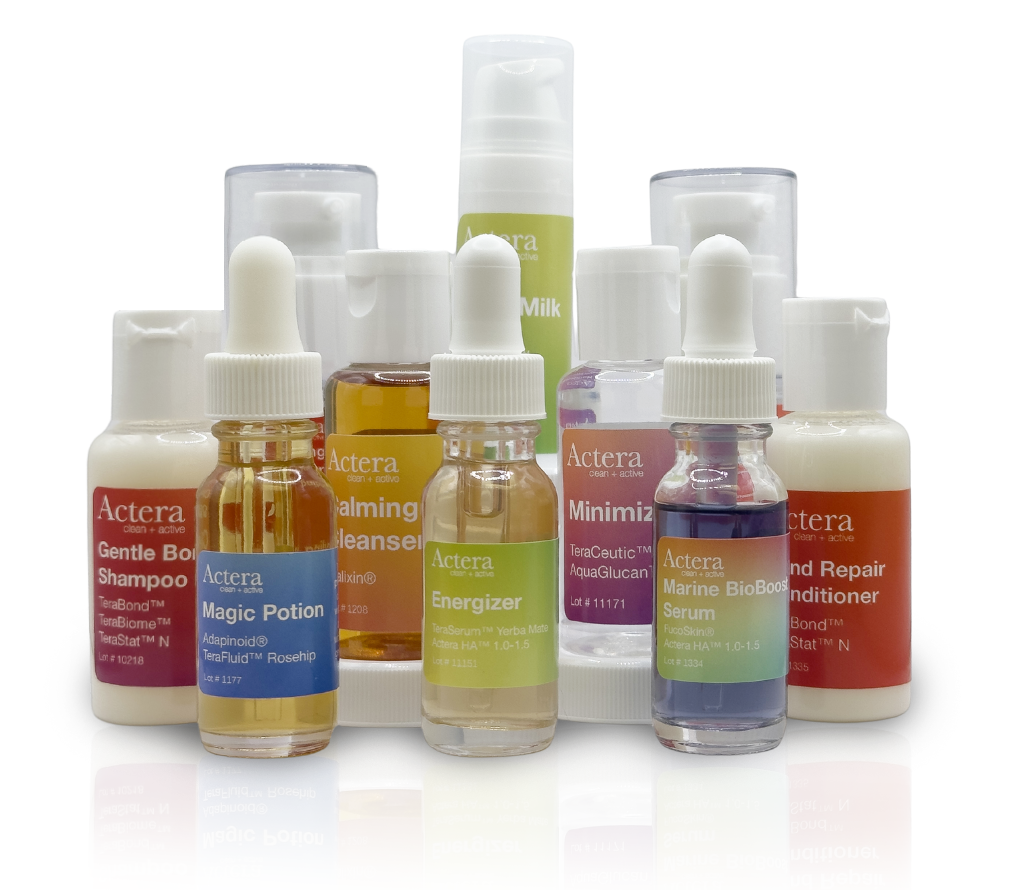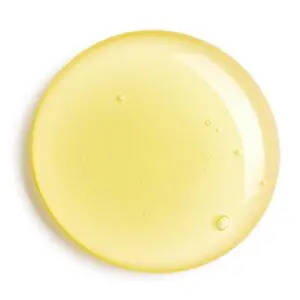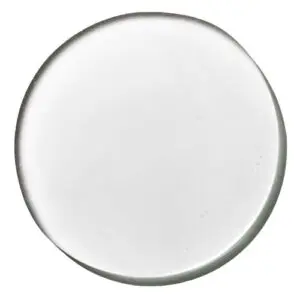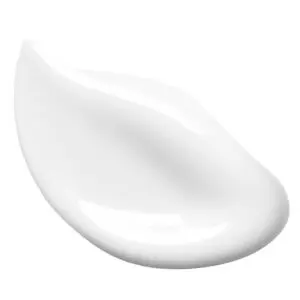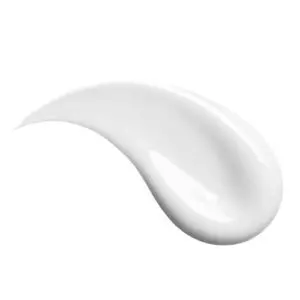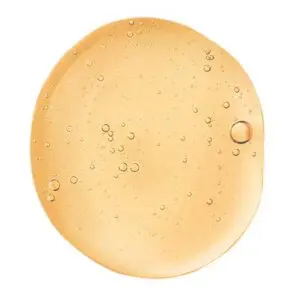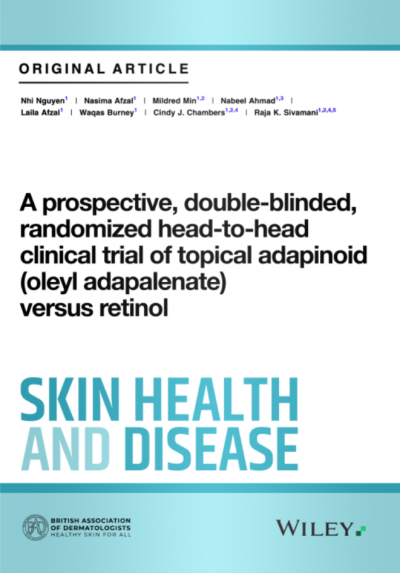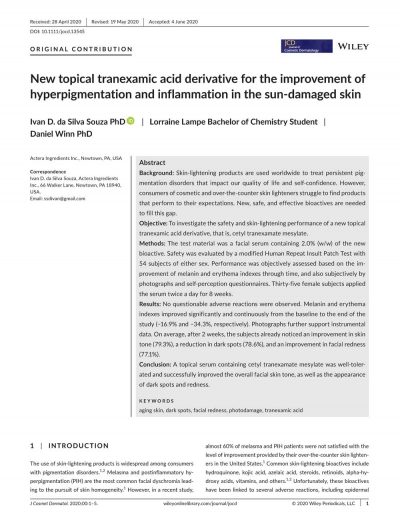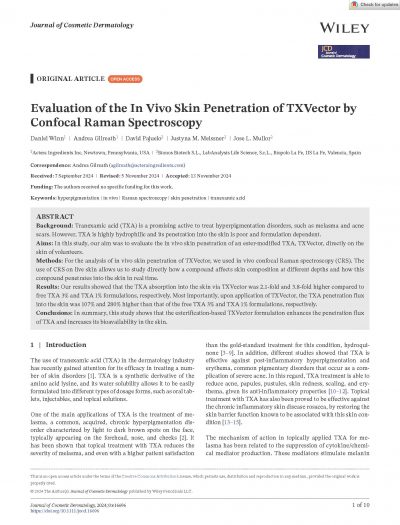In the hyperpigmentation and brightening space, tranexamic acid (TXA) has earned respect for its anti-inflammatory and anti-plasmin potential, but in reality, it’s minimally effective in topical formats because of one tricky challenge: it’s hydrophilic so skin permeation is very limited. That means much of the applied dose stays stuck at the lipophilic skin surface (stratum corneum), never reaching the viable epidermis where melanocytes reside and pigment production takes place. Enter TXVector from Actera — an ester prodrug version of TXA tailored for better skin delivery and superior efficacy. In this article, we break down how the chemistry works, what published research shows, and why Cetyl Tranexamate Mesylate outperforms traditional TXA.
FAQ Quick Links:
- Is TXVector safe?
- What results should I expect from TXVector?
- How much TXVector should be used in a formula?
- Can TXVector be combined with other actives?
- What thickeners/emulsifiers can be used with TXVector?
- Is TXVector just for hyperpigmentation?
- How soon will consumers see results?
- Can TXVector be used with AHA’s and BHA’s?
Formulator 411: What exactly is TXVector and How Does It Work?
- TXVector is a biocompatible prodrug form of tranexamic acid.
- Structurally, it’s an ester derivative of TXA where the carboxyl group is modified with a cetyl (C16) ester moiety, which imparts more lipophilicity along with a mesylate counterion to balance charge. Because of this esterification, TXVector is less hydrophilic than TXA, making it more friendly to lipid domains, which improves its partitioning into the stratum corneum’s lipid matrix.
- Once the molecule penetrates past the barrier, local epidermal esterases can cleave the ester bond and release free TXA in situ where it tackles hyperpigmentation at the source. This solves the skin permeability challenge of traditional TXA.
- TXVector’s smart delivery targets inflamed melanin and treats PIE and PIH by way of melanogenesis modulation and plasmin inhibition. This mechanism of action gives an overall even complexion without the concern of unwanted depigmentation or “bleaching” the skin.
- Fun fact: TXVector has dual functionality due to its structure: it can act as a cationic emulsifier (oil-in-water) in some systems, so it gives both active delivery and functional performance in one!
In short: We’ve re-engineered hydrophilic TXA into a more lipophilic, skin-permeable form that enables delivery of TXA deep inside the skin.
Why Traditional TXA Fails in Topical Formulations
To appreciate the benefit of TXVector, let’s recap the limitations of traditional tranexamic acid:
Poor Barrier Penetration
TXA is hydrophilic and carries strong hydrogen bonding capacity. That means it has difficulty partitioning into the lipid-rich stratum corneum. Many free TXA molecules end up lingering in the outer layer or even being washed off.
Dose Dependence and Diminishing Returns
Minimal amounts make it through the skin barrier, formulators often need relatively high concentrations (e.g. 3–5 %) of TXA to see an effect. But ramping up the concentration of hydrophilic actives complicates emulsion balance, rheology, stability, and could potentially lead to skin irritation.
Slow Flux / Kinetics
Even if some TXA does penetrate, its flux (rate of penetration) is lower, meaning that by the time it gets deeper, much might already be metabolized or lost. This is especially problematic in skin, where turnover, enzymatic degradation, and diffusion challenges compete.
Formulation Constraints
TXA is polar, it often demands co-solvents, penetration enhancers, or special vehicle designs like liposomes, micelles, chemical enhancers. Many such systems add complexity and may cause irritation or stability issues.
Due to these limitations, many TXA serums show modest results, or require long treatment times. These challenges are also why formulations with TXA often include supplemental skin brighteners, like vitamin C and niacinamide, to help pick up the slack.
What the Data Says: TXVector vs TXA
Actera and independent groups have comparing TXVector to TXA in terms of penetration and effectiveness. Some highlights:
- An in vivo clinical study using confocal Raman spectroscopy to deliver much more tranexamic acid (TXA) into the skin than conventional free-TXA formulas: about *2.1× higher compared to 3% TXA, and 3.8× higher compared to 1% TXA
- The penetration flux (µg/cm²·h) was 280% higher than the equivalent dose of TXA. That means not only does more active go into the skin, but it goes in faster.
- In an 8-week clinical use test with 35 women using a 2% TXVector serum twice daily, significant reductions were reported in both dark spots and redness. Melanin index of dark spots was reduced by 16.9% and erythema index by 34.3% from baseline.
- In that same trial, subjects reported noticeable improvement in skin tone (~79 %), reduction in dark spots (~79 %), and improvement in facial redness (~77 %) after just 2 weeks.
- Importantly, safety is also proven. In a Human Repeat Insult Patch Test (HRIPT) with 54 subjects applying 2% TXVector, no adverse reactions or sensitization were reported.
- In a study on acneic, dark skin types (Fitzpatrick types III-VI), hyperpigmentation linked to acne scars began improving in as little as 3 days. This rapid effect is attributed to TXVector’s ability to target sites of excess, inflammatory melanin production.
This data shows that TXVector delivers more TXA into viable skin where it has a powerful effect on inflammatory hyperpigmentation.
Caveats & Considerations for Efficacy
Though TXVector improves delivery, efficacy ultimately depends on two things: how well optimized the formula is to support proper function of the active and the overall health of the skin barrier. A few practical points to keep in mind:
- TXVector is cationic, meaning it’s incompatible with strongly anionic thickeners and emulsifiers. Formulators should be careful to choose compatible vehicle ingredients.
- The optimal pH range is around 3.5 to 5.0, which aligns fairly well with many brightening systems.
- Since TXVector is an ester prodrug, the rate of delivery is enzyme-dependent. In compromised skin, or in certain populations, the esterase activity might vary and influence conversion efficiency.
With any active barrier, integrity and overall formulation synergy remain essential.
As research suggests and clinical data proves, TXVector is a powerful example of smart prodrug design. It’s an expertly designed molecule that solves one of the most stubborn challenges in topical delivery: skin penetration. TXVector delivers more TXA into live skin with faster absorption while avoiding the many challenges of traditional TXA.
FAQ
Is TXVector safe?
Yes. A Human Repeat Insult Patch Test (HRIPT) with 54 subjects found no irritation or sensitization at 2% use. Clinical testing showed good tolerability, with no adverse events or reactions reported and no subject withdrawal.
What results should I expect from TXVector?
Study subjects and consumers report rapid improvement in post-inflammatory hyperpigmentation, acne scars, dark spots, redness, and overall tone balance and clarity.
How much TXVector should be used in a formula?
Recommended use levels are 1–5%, with many studies using 2% and 4%. Because it’s more efficient than traditional TXA, lower doses can achieve similar or better results than higher amounts of traditional TXA.
Can TXVector be combined with other actives?
Yes. TXVector pairs well with many actives, including soothing and hydrating actives. While TXVector is a powerful brightener on its own, it can also pair well with other brightening ingredients like niacinamide and oil soluble vitamin C derivatives, such as tetrahexyldecyl ascorbate. Stacking several actives at lower levels can also help lower overall formulation cost.
What thickeners/emulsifiers can be used with TXVector?
TXVector is cationic. Formulators should avoid strong anionic thickeners or emulsifiers that might negatively impact stability. Common anionic thickeners such as carbomer, xanthan gum, or acrylates are not compatible with TXVector. Non-Ionic and cationic emulsifiers and gums such as HEC, Guar HPTC, sclerotium gum, locust bean gum, and tamarind gum are found commonly in formulas including TXVector. A list of compatible thickeners and emulsifiers can be found on the TXVector technical data sheet.
Is TXVector just for hyperpigmentation?
While dark-spot reduction is the main benefit, studies also showed improvement in facial redness and overall tone uniformity. It’s multifunctional: brightening + soothing.
How soon will consumers see results?
In studies, subjects reported noticeable improvement in as little as 3 days, with significant reductions in dark spots and redness by 8 weeks.
Can TXVector be used with AHA’s and BHA’s?
Yes, TXVector can be used with AHA’s and BHA’s such as salicylic acid, glycolic acid, lactic acid, mandelic acid, kojic acid, etc.

